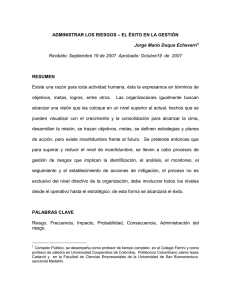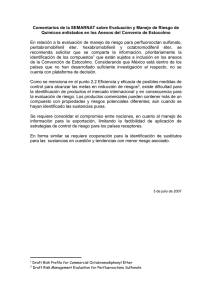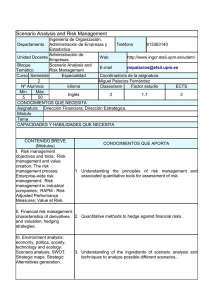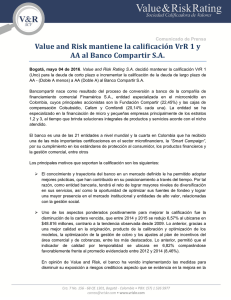Risk Management II (on-line)
Anuncio
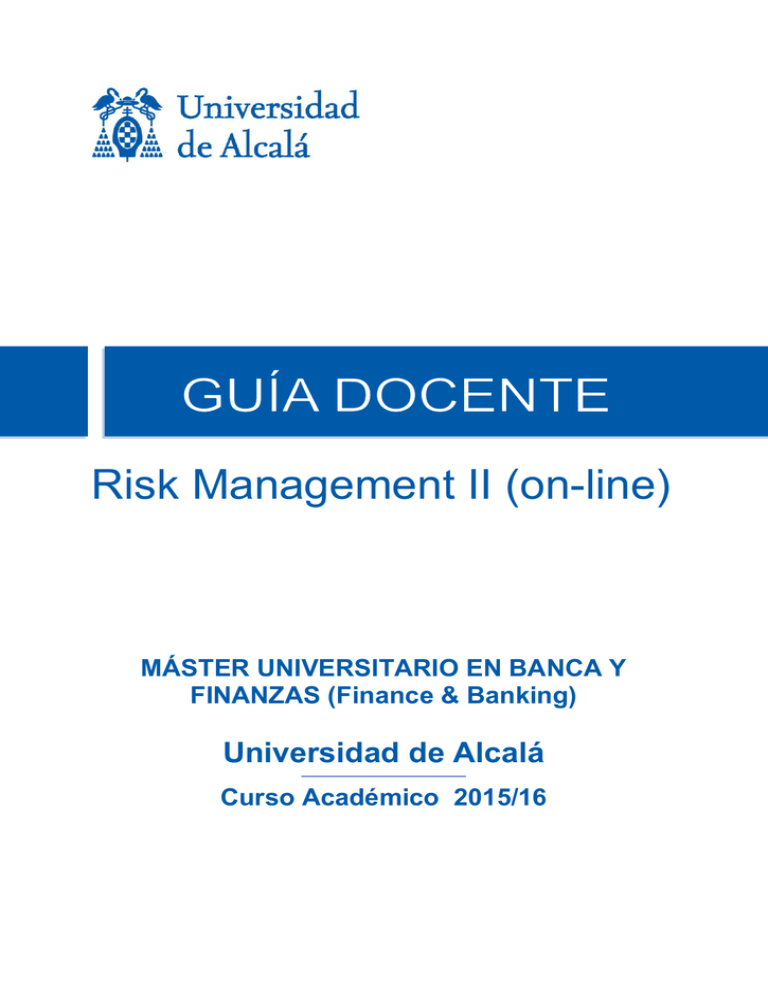
Risk Management II (on-line) MÁSTER UNIVERSITARIO EN BANCA Y FINANZAS (Finance & Banking) Universidad de Alcalá Curso Académico 2015/16 GUÍA DOCENTE Nombre de la asignatura: Código: Risk Management II (on-line) 201564 Departamento y Área de Conocimiento: MÁSTER UNIVERSITARIO EN BANCA Y FINANZAS (Finance & Banking) Departamento de Economía y Dirección de Empresas Carácter: Créditos ECTS: Virtual 3 Curso y cuatrimestre: 1º Profesorado: Pilar Requena Cabezuelo Profesor Titular UAH Horario de Tutoría: 16:30 – 17:30 h. Idioma en el que se imparte: Inglés Titulación en la que se imparte: 1. PRESENTACIÓN Risk management is becoming more and more important everyday. Nowadays, especially in the scenario of crisis that we are going through, risk management is playing a key role in finance. Among the different types of risk, we can highlight the ones related to Credit Risk and Market Risk. In this subject we will introduce both types, as well as the main approaches in measuring them. Prerrequisitos y Recomendaciones (si es pertinente) 2. COMPETENCIAS Competencias genéricas: 1. Is to provide an introduction to some fundamental topics about Market and Credit risk and specially the main models to measure them. Students should be able to understand those factors of risk and deal with the appropriate tools –such as VaR and others- to measure it in practice. 2. Understand the risk concept in financial institutions. 3. Acquire the skills of risk analysis. 4. Introduce students to the concepts and terminology of Risk Management. 5. Risk Management is the activity of recognizing risks, risk evaluation and the development of strategies to manage and mitigate risks using management tools. The strategies include the transfer of risks to the other party, risk hedging, reducing the negative effect of risk and accepting certain consequences of particular risks. Competencias específicas: 1. Know the main risk management tools. 3. CONTENIDOS Total de clases, créditos u horas Bloques de contenido (se pueden especificar los temas si se considera necesario) Market risk: - Introduction to Market Risk - Value-at-Risk introduction 4h 4h 4h 4h Market risk: - Measuring Value-at-Risk: fix income and full valuation Credit risk: - Introduction to Credit Risk - Reduced form models Credit risk: - Structured models - Measuring Credit risk Cronograma (Optativo) Semana / Sesión Contenido 01ª 02ª 03ª Market risk: - Introduction to Market Risk - Value-at-Risk introduction Market risk: - Measuring Value-at-Risk: fix income and full valuation Credit risk: 04ª - Introduction to Credit Risk - Reduced form models Credit risk: - Structured models - Measuring Credit risk 4. METODOLOGÍAS DE ENSEÑANZA-APRENDIZAJE.-ACTIVIDADES FORMATIVAS 4.1. Distribución de créditos(especificar en horas) Número de horas presenciales: 16 Número de horas del trabajo propio del estudiante: 24 Total horas 40 4.2. Estrategias metodológicas, materiales y recursos didácticos For every week the instructor will release a main material about the topic which should be taken as the basic reference for the class. The instructor may also give some other extra material if necessary. This material should be read carefully since the students will be asked to do some activities related with the topic, as for example searching information, giving opinions or write some programs in Excel. 5. EVALUACIÓN: Procedimientos, criterios de evaluación y de calificación1 The assessment of the subject will consist in 2 assignments, which should be submitted to the professor before the deadline. The assignments will be based on theoretical or practical questions about the readings. 1 Es importante señalar los procedimientos de evaluación: por ejemplo evaluación continua, final, autoevaluación, co-evaluación. Instrumentos y evidencias: trabajos, actividades. Criterios o indicadores que se van a valorar en relación a las competencias: dominio de conocimientos conceptuales, aplicación, transferencia conocimientos. Para el sistema de calificación hay que recordar la Normativa del Consejo de Gobierno del 16 de Julio de 2009: la calificación de la evaluación continua representará, al menos, el 60%. Se puede elevar este % en la guía. The final grade will be the arithmetic mean of the 2 grades of each of the assignments. If any of the assignments is missed the student will be graded with a zero on that particular assignment. 1. Attendance: 5% 2. Participation: 40% 3. Objective Test: 25% 4. Final Exam: 30%. 6. BIBLIOGRAFÍA Bibliografía Básica Bibliografía Complementaria (optativo)
